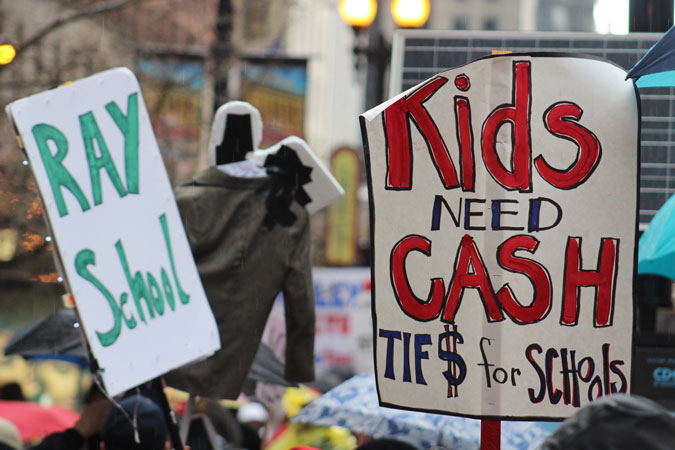
An overwhelming display of organizational manpower was in effect around the city on Friday, April 1 when the Chicago Teachers Union (CTU) executed a one-day strike that began with the union addressing its concerns about ongoing contract talks with Chicago Public Schools CEO Forrest Claypool.
Many other groups affected by labor negotiations and the Illinois budget stalemate and cuts chimed in with support on what CTU called “A Day of Action.”
Republican Illinois Gov. Bruce Rauner has made it his priority to break down unions, pushing “right to work” zones and trying to limit the negotiating power of union members. This has caused high tension between the governor and the Illinois Speaker of the House, Democratic leader Mike Madigan and created the budget stalemate.
The budget stare down has drastically affected Chicago public schools and caused much consternation for Mayor Rahm Emanuel.

Once considered friends and vacation buddies – though they still may be – Rauner and Emanuel have locked horns over Rauner’s budget gridlock and $480 million in funds that could be appropriated to Chicago schools, which would allow CPS some breathing room.
The cash strapped schools’ budget has hemorrhaged without the $480 million it was expecting from the state for pension relief.
Meanwhile, as the fate of Chicago school students lay on the cross of the feuding General House Assembly and the Governor, other students are also taking the hit at public universities and community colleges throughout Illinois.
Chicago State University, where almost 83 percent of the school’s enrollment is African-American, is on the brink of closing. Unlike other institutions such as the University of Illinois at Normal or University of Illinois/Chicago that have a sustainable reserve to roll into the following school year, CSU is expected to run out of money shortly after its spring graduation later this month.

Students and faculty members from neighboring schools such as Eastern Illinois University were bused in on Friday to participate in a teach-in on the Day of Action.
A group of freshman students commented on the serious impact that the budget crisis has had on their college experience.
One said, “Our teachers are trying to fight for our schools; we’re fighting for our school. We have asked ourselves, are we actually going to be here next year, should we look into other schools? That’s the frustrating part and we shouldn’t have to deal with that. It’s just stressful overall as a college student.”
Across town, a similar scene played out at Northeastern Illinois University on the North Side, where the school campus serves a predominately Hispanic student body. They are also facing serious cutbacks due to the state budget crisis.
The serious nature of these colleges closing does not rest primarily on the student’s tuition, but the cutbacks affecting hundreds of jobs that sustain economic stability in their communities.
Fight For 15 In The House
The Day of Action also saw the presence of workers from the “Fight for 15,” whose stance on raising the minimum wage started with McDonald’s restaurant workers and rolled into a national wave.
The current minimum wage is $8.25 per hour in Illinois compared to $10 per hour in California. With the rising costs of state, county and city taxes, this is barely enough to meet the slimmest of living necessities. 
As the schedule of teach-in, protests and picket lines winded down, each group joined the collective movement at Randolph and Clark Street to march through the Loop at rush hour.
With creatively designed signs and humorous memes showing the protestors’ disdain for Rauner, Emanuel and Claypool, it was a lively and motivated turnout.
The rally and march was important to former college student Angel Mitchell, who has worked for McDonald’s for four years and has just barely began making the money to begin her student loan payments this fall.
She felt it was important to attend the demonstrations to help set the foundation for building a better future to begin her post-grad education and live without financial struggle.
Mitchell said that when it comes to the lack of funding in this state, it affects everyone and all the labor forces. That’s why she chose to be there, she explained, because of her belief that no one is separate when it comes to the funding.
“My situation would be better,” she said. “I can’t move just yet because I have no savings and I can’t save on what I’m being paid now. I believe in my heart if we keep fighting, we will get our $15 an hour increase.”

Since March 2015, childcare credits and state assistance have taken a dramatic fall, leaving many small and mid-sized daycare providers forced to close down their businesses.
Without the assistance of these credits issued to low-wage workers and student parents, some are forced to lose their jobs in order to stay at home with their small children.
This is not just one area of disruption; it has an interlocked domino effect so that when one limb is cut off, the entire body suffers. Therefore, a variety of groups’ individual agendas were on the national stage during Friday’s protest.
SEIU Healthcare and other local union members continue to fight for homecare providers and the cuts that face Illinois senior residents.
Strength In Numbers
ChiACTS Local 4343 President Brian Harris believed it was important to support the efforts of CTU.
A great many charter schools service students from disadvantaged and low-income Black and Latino communities, but the state has cut $13.5 million in funding to charter schools across the city.
“We’ve always been very supportive of CTU,” Harris said. “We’ve had a strong relationship with them because we recognize that we’re all just teachers working to serve the people of Chicago. When the state budget refuses to fund schools, it harms us all.”
Harris says because ChiACTS members have contracts due to the collective bargaining agreement in place, they are not on strike. “We have members that are doing various actions, though, as well as some members who will be joining picket lines at CPS schools,” he said.

The solidarity in numbers at the steps of the Thompson Center at the meet-up place at Randolph and Clark was an aerial view of bodies coming together to hear a unified message of change.
Among them were parents, students, teachers, administrators, public officials, faith leaders and community activists. Some took the stage representing different groups, including Dyett School hunger strike leader Jitu Brown, Rainbow/PUSH founder Rev. Jesse Jackson and CTU President Karen Lewis.
Lewis stood proudly, taking in the thousands packed in the Illinois State Building’s open court. She said, “This is what happens when we all decide to come together and stop fighting each other and know who our real enemies are. Don’t let these people fool you into the ‘okie-doke.’”
As attendees applauded and cheered, she continued, “We are here not only for the young children of Chicago – we’re here for the young adults. We’re here for people who deserve and are entitled to a real future.

“Gov. Rauner should pay for four years of tuition for the place that he stole for his daughter when they lived in the suburbs. We’ve got a bill for you, Governor.”
Lewis acknowledged the various organizations in attendance, noting that no fight can be won alone. But unsaid was the question of what happens now when the crisis continues to rise from months of backed up debt and loss of jobs and programs?
Critics questioned the effectiveness of the Day of Action when over 20,000 people shut down the busiest streets in the Loop, triggering a terrible evening rush hour traffic headache for downtown Chicago.
Through perseverance, the Chicago Teachers Union showed on the Day of Action that proper planning and organization can build numbers. The strength of the power in those numbers could potentially replace the old political machine with a new one.



